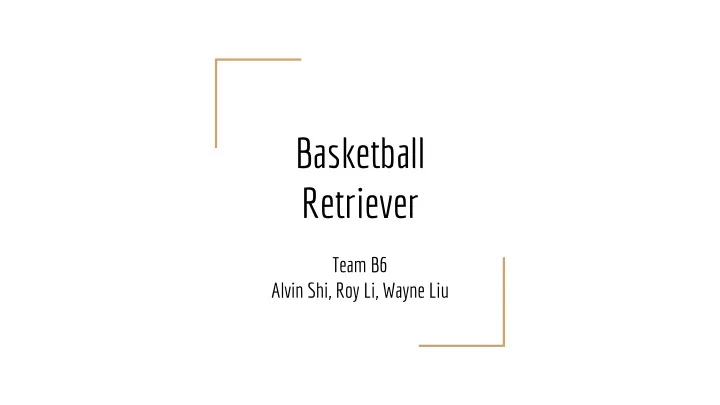

Basketball Retriever Team B6 Alvin Shi, Roy Li, Wayne Liu
Use Case Problem: When practising basketball shooting alone, it is a hassle to pick up the ball after every single shot. Current Status: A machine with a huge net under the rim that covers all the area that the ball might bounce to. Solution: A basketball retriever that picks up the ball and returns it to the player.
Requirements 1. Robot should understand when to pick up the basketball. a. When the ball is at least 2 meters away from the player. 2. Robot should be able to track the basketball while moving at a reasonable speed. a. For each frame taken in a well-lit, indoor environment, the software should have at least 90% accuracy in finding the ball b. The robot should move with an average velocity of 0.5m/s
Requirements 3. Robot should be able to grab the ball with a decent success rate. a. On open field, the success rate should be above 90% b. When the ball is on the side or the corner of the gym, the success rate should be around 50% 4. Robot should be able to bring the ball back to the player. a. The robot should move with an average speed of 1m/s if the player is stationary. b. The robot should keep the ball in control.
Solution Approach - Mechanical
Solution Approach - Electrical and Computer Key Components: 1. NVIDIA Jetson TX2 Module (self-funded) 2. Distance Sensor: Ultrasonic or Infrared (owned) 3. Optor Visual Inertia Camera (owned) 4. Pololu 12VDC, 50:1 170oz-inc Metal Gearmotor ($24.95/per piece) a. Motor spec: 170oz-in & 160RPM b. Assumption: Robot weighs 2kg. c. Requires approx 77 RPM. RPM=60v/(2 ℼ r) d. Requires 85oz-in. T=Fd
Solution Approach - Electrical and Computer Key Techniques: 1. Computer Vision Player Recognition: Apriltag on player. Assume people during demo. ● Ball Recognition: Object detection. ● Camera Calibration: Get correct intrinsic and extrinsic camera params. ● Distance Measure Player & Ball: Stereo Vision ●
Solution Approach - Electrical and Computer Key Techniques: 2. Control & Path Planning Searching: Perform basic searching when have no ball in view. ● PID Control: Generate smooth and efficient motion when tracking and ● approaching the ball. Motor Encoder: Generate accurate motion when close to the ball. ● 3. Distance Sensor (Ultrasonic or Infrared) Ensure enclosing the ball. ●
Testing, Verification and Metrics Unit Testings 1. Fed with images taken by the camera in Wiegand gym, the software should identify the basketball correctly based on the requirements. 2. Fed with the images with a player with an Apriltag and people around, the software should identify the person correctly based on the requirements. 3. Fed with the images with both a player with an Apriltag and a basketball, the software should be able to tell if the ball is sufficiently away. 4. The mechanical system can maneuver in Wiegand gym with minimum speed of 0.5 m/s 5. When the ball is sufficiently close, the robot is able to capture the ball with the required success rate.
Testing, Verification and Metrics System Testing 1. The robot is able to start tracking the basketball after the player made the shot, capture the basketball and return it to the same player with the requirement speed and accuracy.
Tasks and Division of Labor Mechanics: Alvin Shi, Wayne Liu Electronics and Robot Control and Backend Software System: Roy Li Computer Vision: Alvin Shi, Wayne Liu
Schedule Deadline Task 2/25 Robot mechanics and Ball detection Algorithm 3/18 Robot control, electronics and the measurement of relative distance between the ball and the player 4/1 Ball capturing in open field, backend integration 4/17 Ball capturing in corners, ball return 4/29 Final Demo
Recommend
More recommend